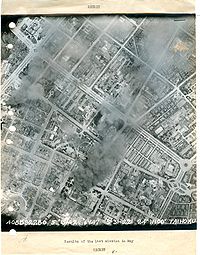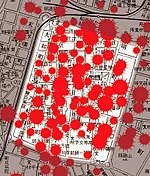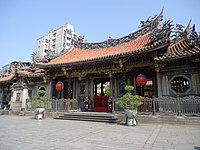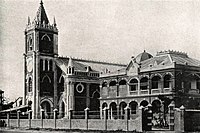Raid on Taipei
| Taihoku Air Raid | |||||||
|---|---|---|---|---|---|---|---|
| Part of World War II, Pacific theater | |||||||
 An aerial photograph by U.S. Air Force | |||||||
| |||||||
| Belligerents | |||||||
|
|
| ||||||
| Strength | |||||||
| Virtually nonexistent | 117 B-24 | ||||||
| Casualties and losses | |||||||
|
Civilians killed: 3,000+ Wounded/Displaced: tens of thousands | none | ||||||
The Taihoku Air Raid[1] was the largest Allied air raid on the city of Taihoku (modern-day Taipei), then under Japanese colonial rule, during World War II. Many residents were killed in the raid and tens of thousands wounded or displaced.
Background
[edit]
As early as 1943, Fourteenth Air Force of the United States Army Air Forces and units of the combined air force of U.S., Nationalist China had launched several air raids against military and industrial targets in Japanese Taiwan. Before this, Soviet volunteer units and combined Chinese and Indian air force had attacked military bases around Taihoku, most of which were targeted on smaller objectives and were of smaller scales. After American ground forces captured Subic Bay in the Philippines, the Allied air forces began larger and more systematic air raids against targets on the island of Taiwan. After 12 October 1944, Allied air forces began scheduled air raids on factories located in Heitō, Kobi, and Port of Takao, and fighter production facility in the outskirt of Takao. Also, Taihoku, the capital and political and financial center of Taiwan, had been under constant aerial assaults by the Allies since that time.
Air raid
[edit]
On 31 May 1945, units of the Fifth Air Force consisting of 117 Consolidated B-24 Liberator heavy bombers were sent to conduct the largest air raid ever on Taiwan. The bombing began from around ten o'clock in the morning and lasted until one o'clock in the afternoon, during which the attack was non-stop. The Americans met virtually no resistance from the Japanese, mainly due to the attrition the Japanese air forces had suffered in the Aerial Battle of Taiwan-Okinawa, which completely exhausted Japan's fighter units in Taiwan. The Allies dropped approximately 3,800 bombs on military units and governmental facilities in Taihoku[citation needed]; many other buildings within the downtown area and Japanese quarter also suffered various damages.
Buildings hit
[edit]

The Office of the Governor-General of Taiwan suffered a direct hit, in spite of the building being heavily camouflaged to avoid being targeted. The building suffered extensive damage from fire caused by the bombs and almost collapsed on itself; it was rendered unoccupiable and was not repaired until the Nationalist Chinese takeover. Other facilities hit during the bombing included the residence of the Assistant Governor-General, Taiwan Railway Hotel, Office of Governor-General Library, Army Headquarters, Taihoku Imperial University, Taihoku Station, Bank of Taiwan, Taihoku High Court, Taihoku New Park, and many other facilities.
Civilian casualties
[edit]Many civilian installations were bombed, including Taihoku Prefectural Taihoku First Girls' High School, Huashan Catholic Church of Taihoku, and the famous Lungshan Temple of Manka, which was hit in the main building and the left corridor; many precious artifacts and art works in the temple were lost in the ensuing fire.[2]
Aftermath
[edit]The number of deaths totaled more than 3,000, which exceeded the total number of deaths resulting from all the previous air raids on Taiwan by the Allies. Tens of thousands of people were displaced or became homeless, and many buildings were destroyed either by the attacks or by the fire caused by the attacks. The air raid showed that the city was defenseless against Allied aerial assaults, and the Governor-General ordered schools and other installations to be evacuated, and that more air raid drills be held.
On 15 July 2009, two duds assumed to be dropped during this raid were found in a construction site of MRT Xinyi Line near Chiang Kai-shek Memorial Hall. Bomb-disposal units of the ROC Armed Forces removed them.
See also
[edit]- Strategic bombing during World War II
- Air raids on Japan
- Evacuations of civilians in Japan during World War II
- Fire-bombing of Tokyo
- Aerial Battle of Taiwan-Okinawa
- Remains of Taipei prison walls
References
[edit]- ^ (traditional Chinese and Japanese: 臺北大空襲; simplified Chinese: 台北大空袭; pinyin: Táiběi Dà Kōngxí; rōmaji: Taihoku Daikūshū; pe̍h-ōe-jī: Tâi-pak Tōa Khong-si̍p)
- ^ "THE INTRODUCTION OF LUNGSHAN TEMPLE". 艋舺龍山寺網站. Retrieved 1 June 2019.
It is well known that the statue of Kuan-in in this temple survived the bombing from the allied aircrafts [sic] on 8 June 1945. Lungshan Temple was bombed on that day. The whole main hall and a part of the right annex were burned out during the air raid, but the statue of Kuan-in in the center of the main hall left intact. This is the most famous manifestation of efficacy of Lungshan Temple.
- 富沢繁 (1984). 台湾終戦秘史: 日本植民地時代とその終焉 (in Japanese). Tokyo: いずみ出版. OCLC 17215324.
- 鍾堅 (1996). 台灣航空決戰 (in Chinese). Taipei: Rye Field Publishing. ISBN 9789577083685.
- 若林正丈 (1990). 台湾百科 (in Japanese). Tokyo: 大修館書店. ISBN 9784469230741.
- 近藤正己 (1996). 総力戦と台湾 : 日本植民地崩壊の研究 (in Japanese). Tokyo: 刀水書房. ISBN 9784887081925.
- 又吉盛清 (1996). 台湾近い昔の旅. 台北編 (in Japanese). Tokyo: 凱風社. ISBN 9784773620054.
- 黃稱奇 (2001). 撐旗的時代 (in Chinese). Taipei: 悅聖文藝. ISBN 9789578231733.
- World War II strategic bombing conducted by the United States
- Second Sino-Japanese War
- Military history of Japan during World War II
- History of Taipei
- 1945 in Taiwan
- Conflicts in 1945
- Military raids
- World War II aerial operations and battles of the Pacific theatre
- Taiwan–United States military relations
- Japan–United States military relations
- May 1945 events
- Airstrikes in Asia
- Taiwan in World War II
- Philippines campaign (1944–1945)
